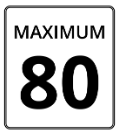16.3: Converting Units
- Page ID
- 39938
Lesson
Let's convert measurements to different units.
Exercise \(\PageIndex{1}\): Number Talk: Fractions of Number
Find the values mentally.
\(\frac{1}{4}\) of \(32\)
\(\frac{3}{4}\) of \(32\)
\(\frac{3}{8}\) of \(32\)
\(\frac{3}{8}\) of \(64\)
Exercise \(\PageIndex{2}\): Road Trip
Elena and her mom are on a road trip outside the United States. Elena sees this road sign.
Elena’s mom is driving 75 miles per hour when she gets pulled over for speeding.

- The police officer explains that 8 kilometers is approximately 5 miles.
- How many kilometers are in 1 mile?
- How many miles are in 1 kilometer?
- If the speed limit is 80 kilometers per hour, and Elena’s mom was driving 75 miles per hour, was she speeding? By how much?
Exercise \(\PageIndex{3}\): Veterinary Weights
A veterinarian uses weights in kilograms to figure out what dosages of medicines to prescribe for animals. For every 10 kilograms, there are 22 pounds.
- Calculate each animal’s weight in kilograms. Explain or show your reasoning. If you get stuck, consider drawing a double number line or table.
- Fido the Labrador weighs 88 pounds.
- Spot the Beagle weighs 33 pounds.
- Bella the Chihuahua weighs \(5\frac{1}{2}\) pounds.
- A certain medication says it can only be given to animals over 25 kilograms. How much is this in pounds?
Exercise \(\PageIndex{4}\): Cooking with a Tablespoon
Diego is trying to follow a recipe, but he cannot find any measuring cups! He only has a tablespoon. In the cookbook, it says that 1 cup equals 16 tablespoons.
- How could Diego use the tablespoon to measure out these ingredients?
\(\frac{1}{2}\) cup almonds
\(1\frac{1}{4}\) cup of oatmeal
\(2\frac{3}{4}\) cup of flour - Diego also adds the following ingredients. How many cups of each did he use?
\(28\) tablespoons of sugar
\(6\) tablespoons of cocoa powder
Summary
When we measure something in two different units, the measurements form an equivalent ratio. We can reason with these equivalent ratios to convert measurements from one unit to another.
Suppose you cut off 20 inches of hair. Your Canadian friend asks how many centimeters of hair that was. Since 100 inches equal 254 centimeters, we can use equivalent ratios to find out how many centimeters equal 20 inches.
Using a double number line:

Using a table:
| length (in) | length (cm) |
|---|---|
| \(100\) | \(254\) |
| \(1\) | \(2.54\) |
| \(20\) | \(50.8\) |
One quick way to solve the problem is to start by finding out how many centimeters are in 1 inch. We can then multiply 2.54 and 20 to find that 20 inches equal 50.8 centimeters.
Practice
Exercise \(\PageIndex{5}\)
Priya’s family exchanged 250 dollars for 4,250 pesos. Priya bought a sweater for 510 pesos. How many dollars did the sweater cost?
| pesos | dollars |
|---|---|
| \(4,250\) | \(250\) |
| \(25\) | |
| \(1\) | |
| \(3\) | |
| \(510\) |
Exercise \(\PageIndex{6}\)
There are 3,785 milliliters in 1 gallon, and there are 4 quarts in 1 gallon. For each question, explain or show your reasoning.
- How many milliliters are in 3 gallons?
- How many milliliters are in 1 quart?
Exercise \(\PageIndex{7}\)
Lin knows that there are 4 quarts in a gallon. She wants to convert 6 quarts to gallons, but cannot decide if she should multiply 6 by 4 or divide 6 by 4 to find her answer. What should she do? Explain or show your reasoning. If you get stuck, consider drawing a double number line or using a table.
Exercise \(\PageIndex{8}\)
Tyler has a baseball bat that weighs 28 ounces. Find this weight in kilograms and in grams. (Note: 1 kilogram \(\approx 35\) ounces)
Exercise \(\PageIndex{9}\)
Identify whether each unit measures length, volume, or weight (or mass).
- Mile
- Cup
- Pound
- Centimeter
- Liter
- Gram
- Pint
- Yard
- Kilogram
- Teaspoon
- Milliliter
(From Unit 3.1.1)
Exercise \(\PageIndex{10}\)
A recipe for trail mix uses 7 ounces of almonds with 5 ounces of raisins. (Almonds and raisins are the only ingredients.) How many ounces of almonds would be in a one-pound bag of this trail mix? Explain or show your reasoning.
(From Unit 2.4.1)
Exercise \(\PageIndex{11}\)
An ant can travel at a constant speed of 980 inches every 5 minutes.
- How far does the ant travel in 1 minute?
- At this rate, how far can the ant travel in 7 minutes?
(From Unit 2.3.4)

